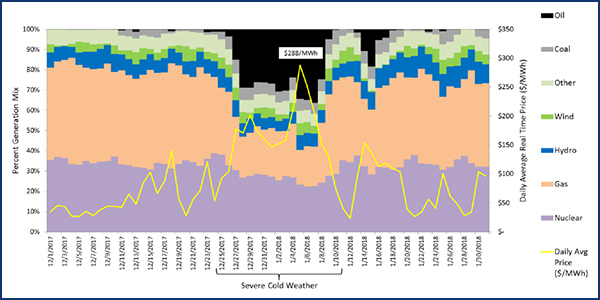By Michael Kuser
Massachusetts electricity suppliers won’t have any trouble this year meeting the state’s new mandate for serving a certain portion of their sales with “clean peak” resources.
That’s because the state’s Department of Energy Resources (DOER) last week set the 2019 minimum to zero while it attempts to work out the details of the Clean Peak Minimum Standard.
“After reviewing available information, the statutory definition of clean peak resources, and a number of other factors, DOER determined that approximately 0 MWh were being served by existing clean peak resources during peak load hours as of December 31, 2018, and established the Minimum Standard percentage requirement for retail electricity suppliers in the 2019 compliance year at 0%,” Director Michael Judge said in a Dec. 31 email to industry stakeholders.
Passed into law last September (H4857), the standard requires DOER to mandate that a baseline minimum percentage of retail electricity sales be met with clean generation resources or load reductions during seasonal peak periods.
Under the law, clean peak resources include qualified renewable portfolio standard and energy storage resources, with an in-service date on or after Jan. 1, 2019, but no such resources could have existed as of Dec. 31, 2018. Demand response resources can also qualify without any specified in-service date, but DOER has yet to establish the eligibility requirements for DR.
The rule is also designed to build on previous performance, with every electricity retailer in the state required to provide a minimum of an additional 0.25% of annual sales with clean peak certificates. But that baseline hasn’t been established yet, nor have any clean peak certificates that would allow for compliance.
In his email, Judge told stakeholders his agency will take the similar tack to how it established the state’s RPS program in 2002.
“At that time, DOER established an ‘early compliance year’ for calendar year 2002, in which the Minimum Standard percentage requirement was established as 0%, but allowed certificates to be generated, purchased, and settled at NEPOOL GIS by retail electricity suppliers for use towards requirements in subsequent calendar years,” Judge wrote. “This allowed the market to commence, but delayed actual compliance filings from retail electricity suppliers by one year.”

ISO-NE generation mix, winter 2017-2018 | Massachusetts Department of Energy Resources
Defining Peak Hours
The idea behind the clean peak standard is to reduce high-cost peak hours and incentivize renewable energy generation to be available to meet winter and summer peaks without emissions. (See New England Clean Energy Legislative Roundup.)
The DOER plans to begin designing the Clean Peak Energy Standard this month, starting with questions for stakeholders that will be posted on the Clean Peak Standard webpage. Following review, the agency will release a detailed straw proposal and solicit comments prior to filing a draft regulation.
The law defines a “clean peak certificate” as “a credit received for each megawatt hour of energy or energy reserves provided during a seasonal peak period that represents a compliance mechanism.”
“Seasonal peak periods” are the daily time windows during any of the four seasons when the net demand of electricity is the highest. Those periods would be no less than one hour and no longer than four hours in any season, as determined by the DOER.
In addition, a qualified RPS resource may generate both a clean peak certificate and a renewable energy certificate under section 11F for electricity generated and delivered to the electric grid during a seasonal peak period.
The stakeholder process is intended to help state regulators establish seasonal peak periods and the methodology for setting clean peak certificate values. Electric service providers may eventually procure such certificates from clean peak resources and enter into long-term contracts, subject to approval by the state’s Department of Public Utilities.
The DOER will also establish a minimum percentage of clean peak certificates to be derived from demand response resources, an alternative compliance mechanism for retailers and procedures for each electricity supplier to demonstrate compliance.

ISO-NE generation mix (2016) | Massachusetts Department of Energy Resources
Comprehensive Energy Plan
The state Comprehensive Energy Plan (CEP) published last month says increased electrification in the transportation and thermal sectors may increase electric load — and peak load, depending on the timing of energy use, especially the charging of energy storage and electric vehicles.
The clean peak standard and technologies such as storage that shift peak flatten this load, “especially as load shifts due to increased EVs, heat pumps, and behind-the-meter solar,” the plan said. “Flattened load enables generators to run at more efficient heat rates, reducing costs and emissions. Further, it reduces the need for future investments in transmission and distribution infrastructure, helping to lower costs of implementing future policies.”
At a public forum last summer, Asa Hopkins of Synapse Energy Economics, a consultant on the CEP said, “Once those clean peak resources are there, it’s not like they’re only there on the peak day; they also run all the rest of the time around the year and are impacting what’s going on with dispatch of different resources.” (See Massachusetts Seeks Input on Energy Plans.)
Demand for natural gas on a peak winter day forces the electric sector to rely on LNG or other stored fuels such as oil for generation, which puts the region at risk for price spikes and emission increases during extended cold weather events, the CEP said. (See ISO-NE Fuel Security Measures Approved.)


